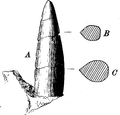Clepsysaurus
| Clepsysaurus Temporal range: Late Triassic, | |
|---|---|

| |
| Holotype tooth (AMNH 2331) of C. veatleianus seen from two different angles | |
| Scientific classification | |
| Domain: | Eukaryota |
| Kingdom: | Animalia |
| Phylum: | Chordata |
| Class: | Reptilia |
| Clade: | Archosauromorpha |
| Clade: | Archosauriformes |
| Clade: | Archosauria |
| Genus: | †Clepsysaurus Lea, 1851 |
| Type species | |
| †Clepsysaurus pennsylvanicus Lea, 1851 | |
| Other species | |
| |
| Synonyms | |
Clepsysaurus (from Greek: κλεψύδρα klepsúdra, 'water thief' and Greek: σαῦρος saûros, 'lizard') is a dubious[1] genus of extinct archosaur from the Carnian[2] Passaic Formation and Lockatong Formation of Lehigh County, and York County, Pennsylvania.[3]
Two species are known: C. pennsylvanicus (the type species)[3] and C. veatleianus.[4]
Discovery and naming
Clepsysaurus pennsylvanicus
The holotype of C. pennsylvanicus, ANSP 9526, 9555-71, 9594-5, consists of teeth, ribs and vertebrae from the Passaic Formation of Pennsylvania.[5] It was described by Isaac Lea in 1851.[3]
Other specimens of C. pennsylvanicus are known, including ANSP 15071 (a left anterior dentary with 23 teeth, a right dentary with 30 teeth and a portion of the right temporal region), AMNH 2337 (a single tooth) and ANSP 15529 (18 large blocks of matrix containing bone material, comprising postcranial and rib fragments alongside 12 small bone fragments comprising vertebral and rib fragments, one isolated vertebral centrum, broken in half laterally and glued together, and 40 small bone fragments, some of them being rib fragments).[6][7]
A left anterior dentary and right dentary, from the Lockatong Formation, found on the farm of George Huber was identified by Colbert (1943) as belonging to C. pennsylvanicus.[7]
Clepsysaurus veatleianus
The holotype of C. veatleianus, AMNH 2331, consists of a single broken tooth, with AMNH 2330, a tooth, as a referred specimen—these were found in the Phoenixville tunnel in York County, Pennsylvania. C. veatleianus was described by Edward Drinker Cope in 1876.[4]
Classification
Clepsysaurus was traditionally classed as a sauropodomorph,[4][5] but more recent studies indicate that it was either a dubious basal archosaur[8] or a member of the Phytosauria.[1] Clepsysaurus was eventually[5] seen as a synonym of either the dubious archosaur Palaeosaurus or the sauropodomorph Anchisaurus, but Clepsysaurus was eventually resurrected as a valid, but dubious, genus.[5][1][7]
Gallery
- AMNH 2330, a tooth referred to C. veatleianus
- C. pennsylvanicus tooth AMNH 3227 seen from two different angles
References
- ^ a b c Stocker, M. R.; Butler, R. J. (2013). "Phytosauria". In Nesitt, S. J.; Desojo, J. B.; Irmis, R. B. (eds.). Anatomy, Phylogeny and Palaeobiology of Early Archosaurs and their Kin. Geological Society, London, Special Publications. p. 379.
- ^ Berg, T.M.; et al. (1983). "Stratigraphic Correlation Chart of Pennsylvania: G75". Pennsylvania Geologic Survey, Harrisburg, Pennsylvania.
- ^ a b c Lea, I. (1851). "Remarks on Clepsysaurus pennsylvanicus". Proceedings of the Academy of Natural Sciences of Philadelphia. 18 (205).
- ^ a b c Cope, E. D. (1877). "Descriptions of extinct Vertebrata from the Permian and Triassic formations of the United States". Proceedings of the American Philosophical Society. 17 (100): 182–193. JSTOR 982295.
- ^ a b c d Spamer, Earle E.; Daeschler, Edward; Vostreys-Shapiro, L. Gay (1995). A Study of Fossil Vertebrate Types in the Academy of Natural Sciences of Philadelphia: Taxonomic, Systematic, and Historical Perspectives. Philadelphia Academy of Natural Sciences. ISBN 978-0-910006-51-4.
- ^ von Huene, F. (1921). "Reptilian and stegocephalian remains from the Triassic of Pennsylvania in the Cope Collection". Bulletin of the AMNH. 44. article 19.
- ^ a b c "Clepsysaurus". Paleofile. Retrieved 2 November 2020.
- ^ Nesbitt, Sterling J.; Desojo, Julia B.; Irmis, Randall B. (2013). "Anatomy, phylogeny and palaeobiology of early archosaurs and their kin". Geological Society, London, Special Publications. 379 (1): 1–7. Bibcode:2013GSLSP.379....1N. doi:10.1144/sp379.21. ISSN 0305-8719. S2CID 85154302.


